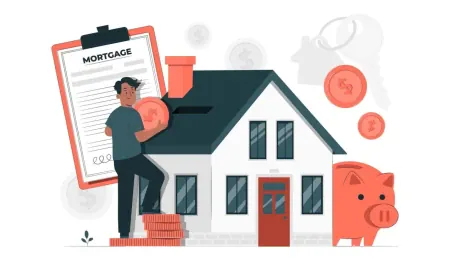Mortgage rates have experienced a significant decline, marking the largest one-week drop in over three months. This development is particularly beneficial for potential home buyers, offering economic relief and enhanced housing affordability. For those navigating the real estate market, this downward trend is a welcome change, providing a new window of opportunity to secure more favorable loan terms. The recent drop in mortgage rates is noteworthy for its breadth, impacting various types of loans and potentially stimulating increased activity in the housing market.
Recent Trends in Mortgage Rates
Over the past three weeks, mortgage rates have been on a consistently downward trend, inspiring optimism among potential home buyers and those considering refinancing. This reduction affects various loan types, including 30-year fixed-rate loans, 15-year loans, and jumbo 30-year loans. The decline from recent peaks earlier in the year has made borrowing more affordable for many, and experts believe this could have a positive ripple effect throughout the real estate sector. The average rate for new 30-year fixed-rate loans dropped to 6.55% as of Friday, marking a 20 basis point decrease over the week.
Similarly, the shift in rates for other loan durations and types has been significant. The rate for new 15-year loans fell to 5.68%, a considerable drop from the previous week’s 5.92%, representing a notable benefit for those opting for shorter-term loans. Jumbo 30-year loans, which often cater to borrowers with higher loan amounts, also saw a decline, settling at an average of 6.65%. These reductions from the respective peaks earlier in the year demonstrate a broad-based easing of financial conditions that potentially lowers entry barriers for many would-be homeowners.
Economic Relief for Borrowers
The reduction in mortgage rates translates into lower monthly payments for borrowers, thereby alleviating some of the financial pressure that accompanies new home purchases or refinancing decisions. This economic relief makes housing more affordable, subsequently encouraging increased activity in the real estate market. A tangible example illustrates the financial impact: a $350,000 loan with a 30-year term now costs $2,224 monthly, a decrease of $126 from the January peak, making new loans more financially manageable for many borrowers.
For a 15-year term loan of the same amount, monthly payments have dropped from $2,995 to $2,893, providing another layer of affordability for those looking at a shorter payoff period. Jumbo loans, which typically feature higher amounts, also benefit from reduced payments, easing the burden for higher-end home purchases. Various loan amounts see different degrees of relief, but the overarching theme is clear—borrowers can now manage their finances with greater ease, potentially spurring greater market participation and stability.
Fluctuations Throughout the Year
Despite recent improvements, mortgage rates have experienced their share of fluctuations throughout the past year. Rates hit high points around Christmas and again in January, before starting to decline in February. This pattern of ups and downs highlights the volatility in the mortgage rate landscape, challenging both borrowers and lenders to stay vigilant and adaptable. However, the current downward trend offers a silver lining for prospective home buyers, making the market more accessible and favorable for new mortgage applications and refinances.
Such fluctuations underscore the importance of timing when securing a mortgage, as well-timed decisions can result in significant savings over the life of a loan. A look back reveals that the recent peaks were daunting for many, causing some potential buyers to pause their home-buying plans. Yet, the recent drop has reignited interest and optimism, indicating that the real estate market can quickly shift from a more prohibitive environment to one that offers substantial opportunities for savings and investment.
Impact on the Housing Market
The consistent reduction in rates across all loan types could stimulate more activity in the housing market, potentially increasing the number of buyers and spurring economic activity within the sector. Lower rates make owning a home more attractive and financially manageable, leading to higher demand for homes and more transactions. This positive shift in mortgage rates helps offset the previous surges observed around the holiday season and in January, rebalancing the market and offering potential homeowners a more favorable landscape.
With more affordable loans, new buyers might be encouraged to enter the market, and existing homeowners might be enticed to refinance, thus unlocking additional disposable income that can be spent elsewhere in the economy. This increased market participation not only benefits individual borrowers but also invigorates the broader housing market, driving up demand for homes, and potentially leading to an uptick in housing construction and related services. This domino effect showcases how a favorable shift in interest rates can reinvigorate broader economic segments and promote growth.
Broader Economic Perspective
Mortgage rates have seen a notable decline, marking the steepest one-week drop in over three months. This is great news for potential homebuyers, as it provides significant economic relief and makes housing more affordable. For those currently navigating the real estate market, this decrease in rates offers a much-needed opportunity to secure better loan terms. The recent dip in mortgage rates is particularly remarkable due to its widespread impact, affecting various types of loans. This trend has the potential to stimulate increased activity in the housing market, as lower rates can encourage more people to buy homes. As a result, both first-time buyers and those looking to refinance their existing mortgages may find this an advantageous time to make a move. Overall, the decline in mortgage rates serves as a positive development, fostering a more dynamic and accessible housing market for many Americans.









